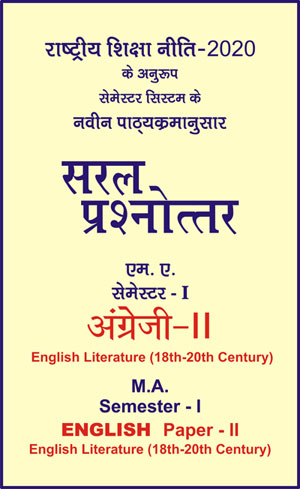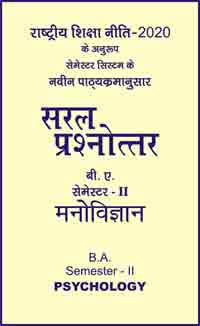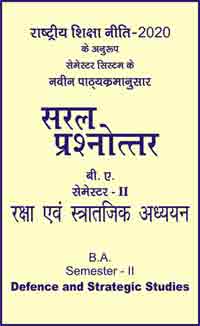|
बी ए - एम ए >> एम ए सेमेस्टर-1 - अंग्रेजी - द्वितीय प्रश्नपत्र - अंग्रेजी साहित्य 18वीं-20वीं शताब्दी एम ए सेमेस्टर-1 - अंग्रेजी - द्वितीय प्रश्नपत्र - अंग्रेजी साहित्य 18वीं-20वीं शताब्दीसरल प्रश्नोत्तर समूह
|
5 पाठक हैं |
|||||||
एम ए सेमेस्टर-1 - अंग्रेजी - द्वितीय प्रश्नपत्र - अंग्रेजी साहित्य 18वीं-20वीं शताब्दी
Question- Comment on the narrative technique in the novel; 'Wuthering Heights'.
Answer -
One way of understanding the narrative technique in Wuthering Heights is to see it as the design of a Chinese Box. A story within a story that can be unravelled by removing one layer after another. A room within a room that the reader keeps entering, in which the rooms are not only physical spaces but also spaces of the mind. It is to be noted how Lockwood enters Wuthering Heights. First- he is outside in the bitter cold and hostile environment. Then he enters the living room of Wuthering Heights where the environment is warm but his reception is not. Later, he goes further into the house and finds himself in Catherine's bedroom where he discovers her diary. The diary is the key to our entry not only to the past but also into Catherine's mind. This progress inside the house is complimented by Lockwood's entry into the past of Wuthering Heights which climaxes with his encounter with Catherine's apparition. Back at Thrushcross Grange, in more comfortable surroundings Lockwood's passage into the past continues with Nelly's recapitulation. This techniques adds a degree of suspense and mystery to the narration and provides a great scope for dramatic shifts- in time and space. At the same time, past and present is woven to together in the way Nelly and Lockwood interpret the events they are witness to. This travel into an internal, closed and dark world approximates the familiar narrative styles of Gothic tales in which the mind is turned on itself and the dark side of the psyche is exposed. But unlike their Gothic predecessors, the narrators of Wuthering Heights are shocked by what they encounter and experience because of the moral and Official standards they represent.
J. Hillis Miller in the essay "Wuthering Heights Repetition and the Uncanny points-out that there is a line of witnesses / narrators, from Emily Bronte to the pseudonymous Ellis Bell to Lockwood to Nelly Dean to Heath cliff to Catherine who form this complex narrative. Reading the novel is like moving inside 'inside of the inside' or sometimes the other way round. Just as there are many narrators in the novel, consequently there are many listeners. Nelly has been the confidant of both Catherine and Heath cliff. Both of them from time to time have felt the need to confide their thoughts to Nelly. A letter from Isabella informs Nelly of the story of Isabella's disastrous married life. Lockwood is Nelly's audience. Ellis Bell knows of Lockwood's story Finally the consciousness of the reader (we) envelops the consciousness of all the other characters including that of Ellis Bell. According to Miller, the reader is condemned to resurrect the ghostly part of Wuthering Heights. Different voices speak to the reader and no one seems to completely comprehend the meaning of the events. The reader is aware of something familiar but is unable to grasp it or even to articulate it. This gives the text its uncanny baffling fervour.
The novel does not follow the pattern of the unity of time and place and event as in the classical Aristotelian sense. Both, Nelly and Lockwood are continuously interpreting what they witness. By doing so, they attribute meanings which are coloured by their own understanding and moral commitments.
Most early critical readings of Wuthering Heights accepted the Nelly-Lockwood desire to explain the central mystery and attribute specific meanings to the relationships in the novel. From this position, the Nelly- Lockwood narration is seen as a appropriate and prosaic recapitulation of a relationship that in essence is raw, pure, wild, intuitive and natural- something transcendental and beyond the limits of reason. It wouldn't be wrong to call Nelly and Lockwood as spectators. One was a sophisticated urbanite while the other a simple peasant woman. The intensity of the drama cut across class or intellectual barriers in the way the novel moves from the world of everyday reality to the world of 'spiritual reality'.
The author's unconventionality was in her ability to create characters like Heathcliff and Catherine who defied present day moral and social desmarcations in order to achieve higher, spiritual levels of meaning and being. 'Wuthering Heights' was a triumph of the Romantic imagination in its quest for an ideal that sought an alternative to the mundane and base nature of everyday to reality.
Some deconstructive analysis suggest that the narrative is designed in the form of frames. The analogy is derived from picture / painting frames. A picture frame encloses within it a picture. Though the focus is on, what is pictured inside the frame, the viewer is aware of what is outside it and not pictured. The 'internal' suggests the 'external' and it is for the viewer/reader to decipher it. There are various boundaries that defines the limits of these frames in 'Wuthering Heights'. There is the outer boundary of a time and place in which Nelly entertains her convalescent master of Lockwood. The inner boundaries consist of the Earnshaw Linton interactions with the Heathcliff - Catherine relationship at its core. The narrator are framers. They encompass a story within a boundary and at the same time they leave certain things out of the frame. Nelly and Lockwood keep surfacing as narrators in the text to remind the readers that the tale is theirs; which makes the reader constantly aware of the idea that there are things beyond the boundaries of the Nelly- Lockwood tale. So the question that we must now face is: Whose story are we reading in the text: Heathcliff - Catherine's or Lockwood - Nelly's ? It seems that we can never really know Heathcliff - Catherine's relationship because they are not the narrators (except for Catherine's diary notes). To conclude, it can be said that Nelly - Lockwood can only impose meaning and sense, whereas Heathcliff - Catherine negate meaning and sense.
|
|||||
- Question- Describe Social and Historicals movements of post modern world wars (I & II).
- Question- Explain the meaning of Romanticism and the Romantic period.
- Question- What is Industrial revolution? Give its main characteristics.
- Question- Write a short biography of John Stuart Mill.
- Question- Write a detail note about Darwinism.
- Question- What do you know about modernism in English Literature?
- Question- What are some main characteristic features of modernism or in modernist literature?
- Question- What do you know about Modernism in Literature? Study it under the following heads- 1. Modern Fiction 2. Modem Poetry 3. Modern Drama.
- Question- What was the 20th century known for?
- Question- What is the theme of 20th century literature?
- Question- Write a note on 'Subjection of women'
- Question- Provide a summary on The Subjection of women chapter I'.
- Question- What is the structure of the Subjection of women?
- Question- What is social and legal status of women?
- Question- Describe Arnold as a prose writer.
- Question- "The pursuit of perfection is the pursuit of sweetness and light". Elucidate.
- Question- How does Arnold say that culture and religion are not in conflict with each other?
- Question- What is according to Arnold the ultimate goal of culture?ply
- Question- How does Arnold criticise the Puritans?
- Question- Write a note on the contribution made to English thought by Ruskin.
- Question- Describe characteristics of Ruskin's socialism.
- Question- Write the summary of the essay The Roots of Truth from "Unto The Last" by John Ruskin.
- Question- Write a note on Ruskin as an art critic.
- Question- Summarise Ruskin's views in Lecture on Work.
- Question- Attempt a critical Analysis of "The Queen's Looking Glass" Written by Gilbert and Gubar.
- Question- Describe the looking glass reveals the existence of patriarchy throughout various fairytales.
- Question- What are the different ways in which women tend to immerse themselves in unhealthy obsessions, and why do they do this?
- Question- What are some of the central dilemmas facing the "independent woman" in de Beauvoir's time?
- Question- How does de Beauvoir respond to those who believe that granting women greater equality means losing the "spice" of life?
- Question- Write a detailed note on Jean-Paul Sartre.
- Question- Write an essay on Existentialism and The Human Emotions.
- Question- Provide a background to Albert Camus's Myth of Sisyphus.
- Question- Provide a summary of the myth of Sisyphus.
- Question- What do you know about Myth of Sisyphus Chapter 1?
- Question- Write a short note on the life-sketch of Albert Camus.
- Question- Evaluate 'Rape of the Lock' as a mock heroic epicpoem.
- Question- What picture of the eighteenth century social life do we find in 'the Rape of the Lock'.
- Question- What did Belinda see in her sleep?
- Question- Discuss Clarrisa's speech in "The Rape of the Lock".
- Question- What items of toiletry stood displayed on Belinda's table in Canto I of "The Rape of the Lock'?
- Question- Discuss Wordsworth's contribution to English criticism.
- Question- Give a critical estimate of Wordsworth's 'Preface to Lyrical Ballads'.
- Question- Summarise William Wordsworth's views on Appendix on poetic diction.
- Question- Write a critical Appreciation of the poem "Tintern Abbey".
- Question- How is "The Rime of the Ancient Mariner' a romantic poem?
- Question- What are some important themes in The Rime of Ancient Mariner'?
- Question- Comment on the use of some important symbols in the poem.
- Question- What do you know about the poem The Rime of the Ancient Mariner'? What is it all about?
- Question- Provide the summary of Part-I of the poem.
- Question- Provide a detailed summary of Part-II of The 'Rime of Ancient Mariner'.
- Question- Provide a summary of Part-III of The Rime of Ancient Mariner'.
- Question- Prodived summary of part-IV of "The Rime of Ancient Mariner'.
- Question- Provide a summary of Part-V of the poem.
- Question- Provide a summary of Part-VI of the Poem.
- Question- Provided a summary of Part-VII of the poem.
- Question- Comment upon limitations of Shelley as a poet.
- Question- Analyse Shelley's treatment of nature.
- Question- Critically examine Shelley's "To a Skylark”.
- Question- Write a note on the use of poetic devices and figures of speech as used in the poem.
- Question- Critically appreciate the poem 'Uphill' in your own words.
- Question- Understand the poem under the following heads.
- Question- What do you know about the poem 'Uphill' ?
- Question- Provide the summary of the poem in your own words.
- Question- How is the poem 'Uphill' a poem of faith, doubt and religious vision?
- Question- Write a note on Eliot's life and works.
- Question- Write a note on the structure of Eliot's 'The Waste Land'.
- Question- Eliot's "The Waste Land' is an expression of the disillusionment of a Generation.'
- Question- How does Eliot explore suffering and hope in The Waste Land' and other poems ?
- Question- Analyse "A Game of Chess".
- Question- What is the significance of Da', 'Da, Da' in the last section of "The Waste Land' entitled 'What The Thunder Said'.
- Question- What are some important themes dealt with in The Second Coming'?
- Question- How is W.B. Yeats' poem The Second Coming' an apocalyptic poem ?
- Question- What is your view is Yeats contribution to modern poetry?
- Question- Write a note on the life of W.B. Yeats and his quest for Irishness.
- Question- How does The Second Coming' reflect the historical context of the time in which it was written?
- Question- How (and why) does The Second Coming' use mythology and ancient themes to express the onset of modernity?
- Question- Describe Yeats The Second Coming' in relationship to several works it has inspired. Why has 'The Second Coming' persisted in the popular imagination.
- Question- Is the 'rough beast' necessarily an evil thing?
- Question- Comment on the use of symbols in the poem.
- Question- What are the various literary devices used in the poem?
- Question- Provide a summary of the poem in your own words.
- Question- "Wilfred Owen as a War Poet". Explain it.
- Question- Give the brief summary of the poem 'Futility' by Wilfred owen.
- Question- Write a critical appreciation of the poem 'Futility'.
- Question- What kind of poem is 'Futility' by wilfred Owen ?
- Question- How does the poet express the pity of war in 'Futility"?
- Question- What is the meaning of the poem 'Futility' by William Blabe?
- Question- What is the main theme of the poem 'Futility"?
- Question- What influenced Wilfred Owen to write war poetry?
- Question- What is the poet's attitude towards war in the poem. 'Futility"?
- Question- 'Was it for this the clay grew tall?' Bring out the Significance of this line?
- Question- 'Move him into the Sun'.............Who is the speaker? Who is to be moved and why?
- Question- 'O What made fatuous Sunbeams toil'....... Why did sunbeams toil? Why are they called fatuous?
- Question- To break earth's sleep at all ?...... What does the poet mean by 'to break earth's sleep?
- Question- Bring out the important themes of the poem, 'Hawk Roosting.'
- Question- How is the poem a dramatic monologue ?
- Question- Provide stanza-wise explanation of the poem.
- Question- Discuss the poem 'Hawk Roosting' as a comment on human society.
- Question- Write a short biography of Ted Hughes.
- Question- Comment on the physical features of the hawk highlighted in the poem and their significance.
- Question- How does the poem emphasize the physical prowess of the hawk ?
- Question- "There is no sophistry in my body' - this statement expresses the brutal frankness of the hawk. Does the poet suggest something through this statement ?
- Question- 'Now I hold Creation in my foot' explain the centrality of this assertion in the poem. What makes the hawk's assertion of its invincibility so categorical?
- Question- Why is the poem titled, 'Hawk Roosting'?
- Question- Bring out the parallel suggested between the predatory instincts of the bird and human behaviour.
- Question- Give a detailed account of life and career' works, influences and achievements of Seamus Heaney.
- Question- How would you visualize Seamus Heaney as a poet?
- Question- Give critical analysis of the poem 'Digging' by Seamus Heaney.
- Question- Discuss the themes used in the poem - 'Digging'.
- Question- Write a biographical note on Synge.
- Question- Provide a summary of the Riders to The Sea.
- Question- What are some important themes of the play?
- Question- Provide a detailed character sketch of Maurya.
- Question- How is 'Riders to the Sea' a classical tragedy?
- Question- What is the role of the sea in 'Riders To The Sea' by J.M. Synge?
- Question- Write a note on the use of symbols in Riders to the Sea.
- Question- Write a note on the popularity of the play.
- Question- Write a note on the human relationship in the play 'Look Back in Anger'.
- Question- Describe Alison's account of her marriage given to Helena.
- Question- Write a note on the title of the play 'Look Back in Anger'.
- Question- Give a brief analysis of the opening scene of 'Look Back in Anger.'
- Question- Give a brief summary of Samuel Beckett's life?
- Question- What is the message given through this play 'Waiting for Godot'?
- Question- Waiting for Godot is a metaphor of human life. Comment.
- Question- Vladimir and Estragon are the main characters of the play 'Waiting for Godot'. Give a brief idea about their characters ?
- Question- Pozzo and Lucky are a pair of master and slave. How was their relationship with each other.
- Question- Harold Pinter as the Absurdist-Existentialist playwright. Explain it.
- Question- What is the theme of the play. "The Home coming" writer by Harold Pinter.
- Question- Writer a brief summary the play, "The Homecoming" written by Harold Pinter.
- Question- What is Harold Pinter's style to writing?
- Question- What is the primary focus of Pinter's Writing in the Homecoming?
- Question- Whose Homecoming it?
- Question- What role of morality in the play "The Homecoming"?
- Question- How does Pinter Portray women and family in The Homecoming?
- Question- What are the issue of misogyny and gender in Harold Pinter's Homecoming?
- Question- What is the general theme of Gulliver's Travels.
- Question- Describe the character of Gulliver in detail.
- Question- Write a note on the realistic effect in Gulliver's Travel.
- Question- Comment upon womenhood and its implications in Richardson's Pamela.
- Question- What are the various themes in the novel?
- Question- Critically appreciate the novel.
- Question- Write a short note on Samuel Richardson.
- Question- Provide a detailed Summary of Pamela; or Virtue Rewarded.
- Question- What is the main theme of the novel?
- Question- Comment on the class differences which is quite a striking feature in Richardson's Pamela.
- Question- Give the character sketch of Pamela.
- Question- What is an Epistolary Novel? What are the advantages and disadvantages of epistolary writing? Explain with reference to the novel 'Pamela'.
- Question- Comment on the society in 18th and 19th Century England.
- Question- What do you know about the earlier affairs in the novel?
- Question- Attempt the character sketch of Mr. B.
- Question- What do you understand by the Industrial Revolution? In what way do you think it changed the relationship between various social groups. Do you think such changes are inevitable?
- Question- Comment on the narrative technique in the novel; 'Wuthering Heights'.
- Question- Provide a summary the novel.
- Question- What do you regard Heathcliff as a Byronic or a Romantic Hero or both? Reason your answer.
- Question- What is the significance of Hindley's remark that his sister looks like a 'lady'? Is lady' the same as 'memsahab?
- Question- How is the institution of marriage discussed in the novel? Elaborate with reference to the Victorian age.
- Question- How does the novel give enough proof of the patriarchal society and how Catherine tries to oppose the malecentric norms set in ?
- Question- What are some important themes of 'Wuthering Heights"?
- Question- How is prison used as a motif in 'Wuthering Heights'.
- Question- Write a short note on the life and works of Emily Bronte.
- Question- Write a short note on Charlotte Bronte.
- Question- Attempt a character Sketch of Jane Eyre.
- Question- How does Charlotte Bronte incorporate elements of the Gothic tradition into the novel?
- Question- Is Jane Eyre a likable protagonist? Why or why not?
- Question- How does Jane Eyre compare to Bertha Marton?
- Question- How does the novel comment on the position of women in Victorian society?
- Question- Considering his treatment of Bertha Mason, is Mr. Rochester a sympathetic or unsympathetic character?
- Question- How does Mr. Rochester compare to St. John Rivers ?
- Question- What is the role of family in the novel?
- Question- Why is Jane unable to stay with Mr. Rochester after his marriage to Bertha Mason is revealed?
- Question- What is the significance of Charlotte Bronte ending the novel with a statement from St. John Rivers?
- Question- Considering the various times the moon appears, what is the significance of the moon motif in Jane Eyre?
- Question- How does Bronte use descriptions of nature in Jane Eyre to set mood?
- Question- Provide a summary of the novel.
- Question- What are the major themes of the novel?
- Question- Give a detailed character sketch of Marlow.
- Question- Provide a detailed character sketch of Mr. Kurtz.
- Question- Critically analyse the various aspects of 'Heart of Darkness'.
- Question- What are the effects of the narrative frame as it is introduced in part of Heart of Darkness?
- Question- In part 1 of Heart of Darkness, what mood is created through the narrator's description of the tide, river and ships?
- Question- What effect does Conrad achieve in Heart of Darkness by layering the narrator's Marlow's and Kurtz's voices in the story?
- Question- In what ways does Kurtz's African mistress in Heart of Darkness contrast with Marlow's aunt and Krutz's Intended?
- Question- In Part 1 of Heart of Darkness, how does the African slave wearing 'white worsted' around his neck in the thicket of death develop the theme of imperialism?
- Question- In heart of Darkness, what are two ways in which Marlow penetrates 'deeper and deeper into the heart of darkness'?
- Question- In the novel, what does Marlow mean when he says that human beings need a 'deliberate belief" in their research for meaning of truth?
- Question- How does the setting of Heart of Darkness support the truth of Marlow's assessment regarding Kurtz that 'the essentials of this affair lay deep under the surface'?
- Question- In the novel, how does the the content of Kurtz's report for the International Society for the Suppression of savage custom contract with the poetscript?
- Question- In what ways are Marlow and Kurtz similar in 'Heart of Darkness'?
- Question- In Heart of Darkness, how does the Russians' clothing resemble the map of Africa in the company office?
- Question- How does the three part division of the Heart of Darkness function?
- Question- During the journey down the river in Heart of Darkness, What is Marlow's relationship with the manager and with Kurtz ?
- Question- In the novel, how do both Kurtz and his Intended suffer from self-delusion?
- Question- How are the beginning and the end of Heart of Darkness similar?
- Question- In what ways is Heart of Darkness a modernist novella?
- Question- D.H. Lowerence novel, 'Women in Love' is called modern man's divided nature. Explain it.
- Question- What are relationship between the works of Lawerence and Nietzschean philosophy 'In women in Love.' novel?
- Question- Character analysis of Gerald Crich and Ursula in novel 'Women in Love'?
- Question- Write a note on plot summary of the novel 'Women in Love.'
- Question- What is the theme of women in love by D. H. Lawerence ?
- Question- What are different themes of 'Women in Love"?
- Question- The two central female characters in 'Women in Love' are both lively and independent. What do the Brangwen sisters (female Characters) tell us about Lawerence's society?
- Question- Describe Gerald Crich and Rupert Birkin's relationship. What does their struggle represent, and why is it so central to the novel?
- Question- In novel 'Women in Love' what is the key difference between Ursula and Gudrun and why is it important for understanding the novel?
- Question- The two central male characters in 'Women in Love' are spirited individual with their social world. Compare and contrast Birkin and Gerald.
- Question- Women in love contains many thoughtful literary allusions most of which are made by Birkin. Choose some key examples and discuss the role they play during important scenes in the novel.
- Question- What are the important themes of 'A Portrait of the Artist as a Young Man' ?
- Question- Comment on the artistic alienation in James Joyce's Portrait of the Artist As a Young Man.
- Question- How is the novel an aesthetic autobiography of James Joyce?
- Question- Analyse the novel critically paying special emphasis on the character of Stephen Dedalus.
- Question- Write a short note on James Joyce.
- Question- Comment on the overall structure of the novel.
- Question- What do you know about Stephen Dedalus ?
- Question- What do you think of the various women that come in Stephen's life in the novel?
- Question- Comment on repetition and symbolism as literary devices used in the novel.
- Question- How is stream-of-consciousness technique employed in 'A Portrait.......? Give one example of epiphany from the novel.
- Question- What do you know about the aesthetic theory put forward by Stephen?
- Question- Provide a detailed summary of the novel.
- Question- Write a note on the symbolic significance of the novel 'To The Light House'.
- Question- Discuss the stream of consciousness technique as used by Virginia Woolf in To The Light House'.
- Question- Write a note on the character of Mrs. Ramsay.
- Question- 'Her novels have been greeted as original experiments in a new technique of fiction, the explorations of the consciousness replacing the exploration of event. 'Discuss with reference to Virginia Woolf's To The Light House'.
- Question- Discuss the theme of the novel To The Lighthouse'.
- Question- Sketch briefly the character of Lily Briscoe.
- Question- 'Consider the novel To The Lighthouse' as a psychological novel.
- Question- How is Mr. Ramsay opposite to Mrs. Ramsay?
- Question- Who is James Ramsay? Who role does he play in "To The Lighthouse"?














